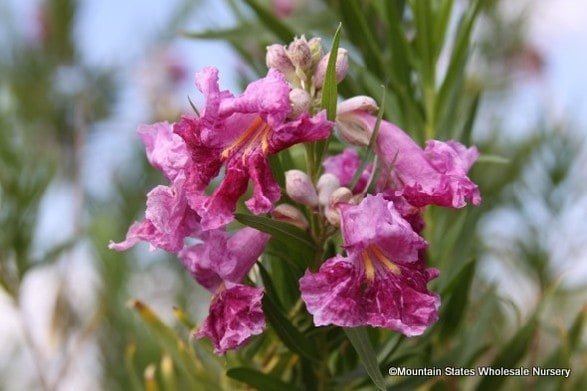Desert Willow
Chilopsis linearis
Family: Bignoniaceae
OTHER NAMES
Spanish: mimbre, jano, janos
CHARACTERISTICS
Deciduous, large shrub or small tree 20-25’. Not a true willow (Salix spp) but named such because of its vague resemblance to willows. Flowers in the warm season with various shades of pink flowers (sometimes white, or purple). The flowers are followed by seed pods that have papery-winged seeds. Lovely smell that some people cannot detect.
There are two subspecies:
Chilopsis linearis subsp. arcuata. Nevada, California, Arizona, Baja California. It has more willowy, bow-shaped foliage.
Chilopsis linearis subsp. linearis. Utah, New Mexico, Texas, Oklahoma, and Chihuahua. It has wider, straighter foliage.
Photo of Chilopsis linearis ‘Art’s Seedless’ by Mountain States Wholesale Nursery
An unusual intergeneric hybrid between Chilopsis linearis and Catalpa bignoniodes is called Chitalpa (xChitalpa tashkentensis) was created in Uzbekistan in 1964 and introduced to the United States by Robert Hebb of the New York Botanic Garden in 1977.
Many cultivars have been selected, with varying flower colors, leaf sizes, and amounts of seed pods. This is an incomplete list as there are new selections made all the time.
'Art's Seedless' - has sterile flowers and no fruit pods.
'AZT Desert Amethyst' - has all purple flowers.
'Bubba' - vibrant pink flowers with a compact growth habit.
‘Goth’ has darker purple flowers
'Lois Adams' - large regal pink flowers with limited seed pods.
'Lucretia Hamilton' - a trademarked cultivar that has a diminutive tree with flowers that are an intense, deep pink to purple color.
'Regal' - has deep pink-purple flowers.
'Tejas' - older cultivar selection made by the late Dr. Jimmy Tipton.
'Warren Jones' - has deep pink-purple flowers.
'White Storm' - beautiful white flowers on a small tree.
LANDSCAPE USE
Screening shrub or small tree.
GROWING CONDITIONS
AN EXPLANATION OF TERMS USED
SUN part to full or even reflected heat
WATER moderate to low water
SOIL tolerant of most soils
HARDINESS hardy to -10°F
BASIN middle
CONTAINER does ok in a container
NUTRITION moderate
MAINTENANCE very little
ECOLOGY
Loved by nectar-loving insects and birds for the flowers, including hummingbirds. Particularly an important nectar source for native bees. Granivorous birds for the seeds, provides important nesting material for several bee species, larval host for several geometrid and sphinx moths including Manduca rustica, the rustic sphinx moth.
ETHNOBOTANY
Bows and basketry made from its wood by indigenous people. A good honey plant. Parts of the plant are used in traditional medicine. It is used to treat fungal infections such as candidiasis and athlete's foot, as well as wounds and cough. The flowers are made into a pleasant tea. Seed is edible and used as food.
NATURAL DISTRIBUTION
Found along dry washes and on the high terraces of river floodplains in the low deserts and foothills, below 5,500 ft. in southern California, southern Nevada, southern Utah, Arizona, southern New Mexico, Kansas, Texas, Oklahoma, and Georgia; south into northern Mexico.
TAXONOMY AND NAME
This plant is in the Bignoniaceae, the trumpet vine family. This is a monotypic genus, there is only one species.
Chilopsis is from the Greek cheilos, a lip, and -opsis, resemblance, referring to the 2-lipped flower; linearis refers to the linear leaves. The subspecies epitaph, arcuata, means bow shaped.
Chilopsis linearis on iNaturalist
Chilopsis linearis on SEINET

Chilopsis linearis 'Bubba' is selected for its flowers. It is not seedless but forms less seeds than the wild species. Photo by Mountain States Wholesale Nursery

Chilopsis linearis 'Desert Diva' has deep, dark, purple burgundy flowers. This one is also somewhat seedless. Photo by Mountain States Wholesale Nursery

Closeup of Chilopsis linearis 'Art's Seedless'. As the name denotes, this species is seedless. Photo by Mountain States Wholesale Nursery

Chilopsis linearis 'Warren Jones' is a clone that grows more quickly than other selections, holds its leaves longer in the winter, and blooms profusely with showy, light pink flowers during the summer months. Photo by Mountain States Wholesale Nursery
Chilopsis linearis subsp. arcuata, the locally native species can have a range of colors, from white to dark pink, and is characterized by its strongly arcuate (curved into an arch-shape) leaves. Photo by Sue Carnahan, SEINET
Chilopsis linearis subsp. linearis has wider, straighter foliage. Photo by Michiko, iNaturalist



